Novel Magnetic Nanohybrids: From Iron Oxide to Iron Carbide Nanoparticles Grown on Nanodiamonds
Abstract
1. Introduction
2. Experimental
2.1. Materials Synthesis
2.2. Materials Characterization
3. Results and Discussion
3.1. XRD
3.2. TEM
3.3. Magnetization and Magnetic Susceptibility
3.4. 57Fe Mössbauer Spectroscopy
4. Discussion
5. Conclusions
Supplementary Materials
Author Contributions
Funding
Acknowledgments
Conflicts of Interest
Abbreviations/Acronyms
| 2ε | quadrupole shift |
| Bhf | hyperfine magnetic field |
| CNT(s) | carbon nanotube (s) |
| CP | chemical precursor |
| FC | field-cooled |
| H | applied magnetic field |
| HAADF | high-angle annular dark field |
| HC(s) | coercive field (s) |
| IC(s) | iron carbide (s) |
| IO(s) | iron oxide (s) |
| IS | isomer shift |
| K | magnetic anisotropy constant |
| M | magnetization |
| MCOL | magnetically collapsing |
| Mmax | maximum M value at 50 kOe |
| MPI | magnetic particle imaging |
| MR | remnant magnetization |
| MRES | magnetically resolved |
| MRI | magnetic resonance imaging |
| MS | saturation magnetization |
| MS | Mössbauer spectra |
| ND(s) | Nanodiamond (s) |
| NP(s) | nanoparticle(s) |
| QS | quadrupole splitting |
| RT | room temperature |
| SM | Supplementary Material |
| SPM | superparamagnetic |
| SQUID | superconducting quantum interference device |
| T | temperature |
| TEM | transmission electron microscopy |
| V | volume |
| vs | versus |
| XRD | X-ray diffraction |
| ZFC | zero-field-cooled |
| ΔBhf | spreading of hyperfine magnetic field |
| τMS-exp | characteristic 57Fe Mössbauer spectroscopy measuring time |
| τ | relaxation time |
| χg | mass magnetic susceptibility |
References
- Giordano, C.; Kraupner, A.; Wimbush, S.C.; Antonietti, M. Iron carbide: An ancient advanced material. Small 2010, 6, 1859–1862. [Google Scholar] [CrossRef] [PubMed]
- Ye, Z.; Zhang, P.; Lei, X.; Wang, X.; Zhao, N.; Yang, H. Iron Carbides and Nitrides: Ancient Materials with Novel Prospects. Chem. A Eur. J. 2018, 24, 8922–8940. [Google Scholar] [CrossRef] [PubMed]
- Bhadeshia, H.K.D.H. Cementite. Int. Mater. Rev. 2020, 65, 1–27. [Google Scholar] [CrossRef]
- Weng, Y.; Dong, H.; Yong, G. Advanced Steels; Weng, Y., Dong, H., Yong, G., Eds.; Springer: Berlin/Heidelberg, Germany; Dordrecht, The Netherlands; London, UK; New York, NY, USA, 2011. [Google Scholar] [CrossRef]
- Hosford, W.F. Iron and Steel; Cambridge University Press: Cambridge, UK, 2012. [Google Scholar]
- Han, K.; Edmonds, D.V.; Smith, G.D.W. Optimization of mechanical properties of high-carbon pearlitic steels with Si and V additions. Metall. Mater. Trans. A 2001, 32, 1313–1324. [Google Scholar] [CrossRef]
- Han, K.; Chen, J.P. Achievable Strength of Nanostructured Composites with Co-Deformable Components. Mater. Sci. Forum 2011, 683, 243–247. [Google Scholar] [CrossRef]
- Li, L.; Virta, J. Ultrahigh strength steel wires processed by severe plastic deformation for ultrafine grained microstructure. Mater. Sci. Technol. 2011, 27, 845–862. [Google Scholar] [CrossRef]
- Elwazri, A.M.; Wanjara, P.; Yue, S. The effect of microstructural characteristics of pearlite on the mechanical properties of hypereutectoid steel. Mater. Sci. Eng. A 2005, 404, 91–98. [Google Scholar] [CrossRef]
- De Smit, E.; Cinquini, F.; Beale, A.M.; Safonova, O.V.; van Beek, W.; Sautet, P.; Weckhuysen, B.M. Stability and Reactivity of ϵ−χ−θ Iron Carbide Catalyst Phases in Fischer−Tropsch Synthesis: Controlling μC. J. Am. Chem. Soc. 2010, 132, 14928–14941. [Google Scholar] [CrossRef]
- Xu, K.; Sun, B.; Lin, J.; Wen, W.; Pei, Y.; Yan, S.; Qiao, M.; Zhang, X.; Zong, B. ε-Iron carbide as a low-temperature Fischer–Tropsch synthesis catalyst. Nature Commun. 2014, 5, 5783. [Google Scholar] [CrossRef]
- Niemantsverdriet, J.W.; van der Kraan, A.M.; van Dijk, W.L.; van der Baan, H.S. Behavior of metallic iron catalysts during Fischer-Tropsch synthesis studied with Mössbauer spectroscopy, x-ray diffraction, carbon content determination, and reaction kinetic measurements. J. Phys. Chem. 1980, 84, 3363–3370. [Google Scholar] [CrossRef]
- Yoshida, H.; Takeda, S.; Uchiyama, T.; Kohno, H.; Homma, Y. Atomic-Scale In-situ Observation of Carbon Nanotube Growth from Solid State Iron Carbide Nanoparticles. Nano Lett. 2008, 8, 2082–2086. [Google Scholar] [CrossRef] [PubMed]
- Schaper, A.K.; Hou, H.; Greiner, A.; Phillipp, F. The role of iron carbide in multiwalled carbon nanotube growth. J. Catal. 2004, 222, 250–254. [Google Scholar] [CrossRef]
- Pérez-Cabero, M.; Taboada, J.B.; Guerrero-Ruiz, A.; Overweg, A.R.; Rodríguez-Ramos, I. The role of alpha-iron and cementite phases in the growing mechanism of carbon nanotubes: A 57Fe Mössbauer spectroscopy study. Phys. Chem. Chem. Phys. 2006, 8, 1230–1235. [Google Scholar] [CrossRef] [PubMed]
- Le Caer, G.; Dubois, J.M.; Pijolat, M.; Perrichon, V.; Bussiere, P. Characterization by Moessbauer spectroscopy of iron carbides formed by Fischer-Tropsch synthesis. J. Phys. Chem. 1982, 86, 4799–4808. [Google Scholar] [CrossRef]
- Abel, F.M.; Pourmiri, S.; Basina, G.; Tzitzios, V.; Devlin, E.; Hadjipanayis, G.C. Iron carbide nanoplatelets: Colloidal synthesis and characterization. Nanoscale Adv. 2019, 1, 4476–4480. [Google Scholar] [CrossRef]
- Lin, J.-F.; Struzhkin, V.V.; Mao, H.-k.; Hemley, R.J.; Chow, P.; Hu, M.Y.; Li, J. Magnetic transition in compressed Fe3C from X-ray emission spectroscopy. Phys. Rev. B 2004, 70, 212405. [Google Scholar] [CrossRef]
- Zhao, X.Q.; Liang, Y.; Hu, Z.Q.; Liu, B.X. Oxidation characteristics and magnetic properties of iron carbide and iron ultrafine particles. J. Appl. Phys. 1996, 80, 5857–5860. [Google Scholar] [CrossRef]
- Schnepp, Z.; Wimbush, S.C.; Antonietti, M.; Giordano, C. Synthesis of Highly Magnetic Iron Carbide Nanoparticles via a Biopolymer Route. Chem. Mater. 2010, 22, 5340–5344. [Google Scholar] [CrossRef]
- Huang, G.; Hu, J.; Zhang, H.; Zhou, Z.; Chi, X.; Gao, J. Highly magnetic iron carbide nanoparticles as effective T2 contrast agents. Nanoscale 2014, 6, 726–730. [Google Scholar] [CrossRef]
- Liang, Y.; Liu, P.; Xiao, J.; Li, H.; Wang, C.; Yang, G. A microfibre assembly of an iron-carbon composite with giant magnetisation. Sci. Rep. 2013, 3, 3051. [Google Scholar] [CrossRef]
- Gao, S.; Yang, S.-H.; Wang, H.-Y.; Wang, G.-S.; Yin, P.-G. Excellent electromagnetic wave absorbing properties of two-dimensional carbon-based nanocomposite supported by transition metal carbides Fe3C. Carbon 2020, 162, 438–444. [Google Scholar] [CrossRef]
- Bordet, A.; Lacroix, L.-M.; Fazzini, P.-F.; Carrey, J.; Soulantica, K.; Chaudret, B. Magnetically Induced Continuous CO2 Hydrogenation Using Composite Iron Carbide Nanoparticles of Exceptionally High Heating Power. Angew. Chem. Int. Ed. 2016, 55, 15894–15898. [Google Scholar] [CrossRef] [PubMed]
- Kale, S.S.; Asensio, J.M.; Estrader, M.; Werner, M.; Bordet, A.; Yi, D.; Marbaix, J.; Fazzini, P.-F.; Soulantica, K.; Chaudret, B. Iron carbide or iron carbide/cobalt nanoparticles for magnetically-induced CO2 hydrogenation over Ni/SiRAlOx catalysts. Catal. Sci. Technol. 2019, 9, 2601–2607. [Google Scholar] [CrossRef]
- Meffre, A.; Mehdaoui, B.; Kelsen, V.; Fazzini, P.F.; Carrey, J.; Lachaize, S.; Respaud, M.; Chaudret, B. A Simple Chemical Route toward Monodisperse Iron Carbide Nanoparticles Displaying Tunable Magnetic and Unprecedented Hyperthermia Properties. Nano Lett. 2012, 12, 4722–4728. [Google Scholar] [CrossRef] [PubMed]
- Liu, X.-W.; Zhao, S.; Meng, Y.; Peng, Q.; Dearden, A.K.; Huo, C.-F.; Yang, Y.; Li, Y.-W.; Wen, X.-D. Mössbauer Spectroscopy of Iron Carbides: From Prediction to Experimental Confirmation. Sci. Rep. 2016, 6, 26184. [Google Scholar] [CrossRef]
- Fang, C.M.; van Huis, M.A.; Zandbergen, H.W. Structure and stability of Fe2C phases from density-functional theory calculations. Scr. Mater. 2010, 63, 418–421. [Google Scholar] [CrossRef]
- Elsukov, E.P.; Dorofeev, G.A.; Ul’yanov, A.L.; Vytovtov, D.A. On the problem of the cementite structure. Phys. Metals Metallogr. 2006, 102, 76–82. [Google Scholar] [CrossRef]
- Ron, M.; Mathalone, Z. Hyperfine Interactions of 57Fe in Fe3C. Phys. Rev. B 1971, 4, 774–777. [Google Scholar] [CrossRef]
- Li, S.; Yang, J.; Song, C.; Zhu, Q.; Xiao, D.; Ma, D. Iron Carbides: Control Synthesis and Catalytic Applications in COx Hydrogenation and Electrochemical HER. Adv. Mater. 2019, 31, 1901796. [Google Scholar] [CrossRef]
- Sajitha, E.P.; Prasad, V.; Subramanyam, S.V.; Mishra, A.K.; Sarkar, S.; Bansal, C. Size-dependent magnetic properties of iron carbide nanoparticles embedded in a carbon matrix. J. Phys. Condens. Matter 2007, 19, 046214. [Google Scholar] [CrossRef]
- Schneeweiss, O.; Zbořil, R.; David, B.; Heřmánek, M.; Mashlan, M. Solid-State Synthesis of α-Fe and Iron Carbide Nanoparticles by Thermal Treatment of Amorphous Fe2O3; Springer: Berlin/Heidelberg, Germany, 2009; pp. 167–173. [Google Scholar]
- Lin, S.C.; Phillips, J. Study of relaxation effects in the 57Fe Mössbauer spectra of carbon-supported iron carbide particles. J. Appl. Phys. 1985, 58, 1943–1949. [Google Scholar] [CrossRef]
- Lipert, K.; Kazmierczak, J.; Pelech, I.; Narkiewicz, U.; Slawska-Waniewska, A.; Lachowicz, H.K. Magnetic properties of cementite (Fe3C) nanoparticle agglomerates in a carbon matrix. Mater. Sci. Pol. 2007, 25, 2. [Google Scholar]
- Pierson, H.O. Handbook of Carbon, Graphite, Diamond And Fullerenes: Properties, Processing and Applications; Noyes Publications: Park Ridge, NJ, USA, 1993. [Google Scholar]
- Shenderova, O.A.; Gruen, D.M. Ultrananocrystalline Diamond: Synthesis, Properties and Applications, 2nd ed.; Elsevier: Oxford, UK, 2012; pp. 1–558. [Google Scholar]
- Vul’, A.; Shenderova, O. Detonation Nanodiamonds: Science and Applications; CRC Press: Boca Raton, FL, USA, 2013. [Google Scholar]
- Mochalin, V.N.; Shenderova, O.; Ho, D.; Gogotsi, Y. The properties and applications of nanodiamonds. Nat. Nanotechnol. 2011, 7, 11–23. [Google Scholar] [CrossRef] [PubMed]
- Bourlinos, A.B.; Zbořil, R.; Kubala, M.; Stathi, P.; Deligiannakis, Y.; Karakassides, M.A.; Steriotis, T.A.; Stubos, A.K. Fabrication of fluorescent nanodiamond@C core-shell hybrids via mild carbonization of sodium cholate-nanodiamond complexes. J. Mater. Sci. 2011, 46, 7912–7916. [Google Scholar] [CrossRef]
- Ho, D. Nanodiamonds: Applications in Biology and Nanoscale Medicine; Springer: New York, NY, USA, 2010. [Google Scholar]
- Chen, M.; Pierstorff, E.D.; Lam, R.; Li, S.Y.; Huang, H.; Osawa, E.; Ho, D. Nanodiamond-mediated delivery of water-insoluble therapeutics. ACS Nano 2009, 3, 2016–2022. [Google Scholar] [CrossRef]
- Douvalis, A.P.; Bourlinos, A.B.; Tucek, J.; Čépe, K.; Bakas, T.; Zboril, R. Development of novel FePt/nanodiamond hybrid nanostructures: L10 phase size-growth suppression and magnetic properties. J. Nanopart. Res. 2016, 18, 115. [Google Scholar] [CrossRef]
- Laurent, S.; Henoumont, C.; Stanicki, D.; Boutry, S.; Lipani, E.; Belaid, S.; Muller, R.N.; Vander Elst, R.N. MRI Contrast Agents: From Molecules to Particles; Springer: Berlin/Heidelberg, Germany, 2017. [Google Scholar] [CrossRef]
- Pierre, V.C.; Allen, M.J. Contrast Agents for MRI: Experimental Methods; The Royal Society of Chemistry: London, UK, 2018. [Google Scholar]
- Knopp, T.; Buzug, T.M. Magnetic Particle Imaging: An Introduction to Imaging Principles and Scanner Instrumentation; Springer: Berlin/Heidelberg, Germany, 2012. [Google Scholar]
- Erbe, M. Field Free Line Magnetic Particle Imaging; Springer: Berlin/Heidelberg, Germany, 2014. [Google Scholar]
- Deatsch, A.E.; Evans, B.A. Heating efficiency in magnetic nanoparticle hyperthermia. J. Magn. Magn. Mater. 2014, 354, 163–172. [Google Scholar] [CrossRef]
- Wang, W.; Tuci, G.; Duong-Viet, C.; Liu, Y.; Rossin, A.; Luconi, L.; Nhut, J.-M.; Nguyen-Dinh, L.; Pham-Huu, C.; Giambastiani, G. Induction Heating: An Enabling Technology for the Heat Management in Catalytic Processes. ACS Catal. 2019, 9, 7921–7935. [Google Scholar] [CrossRef]
- Bourlinos, A.; Simopoulos, A.; Petridis, D.; Okumura, H.; Hadjipanayis, G. Silica-Maghemite Nanocomposites. Adv. Mater. 2001, 13, 289–291. [Google Scholar] [CrossRef]
- Tsoufis, T.; Douvalis, A.P.; Lekka, C.E.; Trikalitis, P.N.; Bakas, T.; Gournis, D. Controlled preparation of carbon nanotube–iron oxide nanoparticle hybrid materials by a modified wet impregnation method. J. Nanopart. Res. 2013, 15, 1924–1927. [Google Scholar] [CrossRef]
- Douvalis, A.P.; Polymeros, A.; Bakas, T. IMSG09: A 57Fe-119Sn Mössbauer spectra computer fitting program with novel interactive user interface. J. Phys. Conf. Ser. 2010, 217, 012014. [Google Scholar] [CrossRef]
- Cornell, R.M.; Schwertmann, U. The Iron Oxides: Structure, Properties, Reactions, Occurrences and Uses; Wiley-VCH: Weinheim, Germany, 2003. [Google Scholar]
- Cullity, B.D.; Stock, S.R. Elements of X-Ray Diffraction, 3rd ed.; Pearson Education Limited: London, UK, 2014. [Google Scholar]
- Gournis, D.; Karakassides, M.A.; Bakas, T.; Boukos, N.; Petridis, D. Catalytic synthesis of carbon nanotubes on clay minerals. Carbon 2002, 40, 2641–2646. [Google Scholar] [CrossRef]
- Cullity, B.D.; Graham, C.D. Introduction to Magnetic Materials; John Wiley & Sons: Hoboken, NJ, USA, 2009. [Google Scholar]
- Khurshid, H.; Lampen-Kelley, P.; Iglesias, Ò.; Alonso, J.; Phan, M.-H.; Sun, C.-J.; Saboungi, M.-L.; Srikanth, H. Spin-glass-like freezing of inner and outer surface layers in hollow γ-Fe2O3 nanoparticles. Sci. Rep. 2015, 5, 15054. [Google Scholar] [CrossRef] [PubMed]
- Cabreira-Gomes, R.; Silva, F.G.; Aquino, R.; Bonville, P.; Tourinho, F.A.; Perzynski, R.; Depeyrot, J. Exchange bias of MnFe2O4@γFe2O3 and CoFe2O4@γFe2O3 core/shell nanoparticles. J. Magn. Magn. Mater. 2014, 368, 409–414. [Google Scholar] [CrossRef]
- Zhu, C.; Tian, Z.; Wang, L.; Yuan, S. Exchange bias effect in spin glass CoCr2O4 nanoparticles. J. Magn. Magn. Mater. 2015, 393, 116–120. [Google Scholar] [CrossRef]
- Giri, S.K.; Poddar, A.; Nath, T.K. Evidence of exchange bias effect and surface spin glass ordering in electron doped Sm0.09Ca0.91MnO3 nanomanganites. J. Appl. Phys. 2012, 112, 113903. [Google Scholar] [CrossRef]
- Fiorani, D. Surface Effects in Magnetic Nanoparticles; Springer: New York, NY, USA, 2005. [Google Scholar]
- Gubin, S.P. Magnetic Nanoparticles; Wiley-VCH: Weinheim, Germany, 2009. [Google Scholar]
- Kostopoulou, A.; Brintakis, K.; Vasilakaki, M.; Trohidou, K.N.; Douvalis, A.P.; Lascialfari, A.; Manna, L.; Lappas, A. Assembly-mediated interplay of dipolar interactions and surface spin disorder in colloidal maghemite nanoclusters. Nanoscale 2014, 6, 3764–3776. [Google Scholar] [CrossRef]
- Mørup, S.; Hansen, M. Superparamagnetic Particles. In Handbook of Magnetism and Advanced Magnetic Materials; Kronmüller, H., Parkin, S., Eds.; Novel Materials; John Wiley & Sons: Hoboken, NJ, USA, 2007; Volume 4. [Google Scholar]
- Li, Q.; Kartikowati, C.W.; Horie, S.; Ogi, T.; Iwaki, T.; Okuyama, K. Correlation between particle size/domain structure and magnetic properties of highly crystalline Fe3O4 nanoparticles. Sci. Rep. 2017, 7, 9894. [Google Scholar] [CrossRef]
- Morelos-Gómez, A.; López-Urías, F.; Muñoz-Sandoval, E.; Dennis, C.L.; Shull, R.D.; Terrones, H.; Terrones, M. Controlling high coercivities of ferromagnetic nanowires encapsulated in carbon nanotubes. J. Mater. Chem. 2010, 20, 5906–5914. [Google Scholar] [CrossRef]
- Liu, D.; Zhu, J.; Ivaturi, S.; He, Y.; Wang, S.; Wang, J.; Zhang, S.; Willis, M.A.C.; Boi, F.S. Giant magnetic coercivity in Fe3C-filled carbon nanotubes. RSC Adv. 2018, 8, 13820–13825. [Google Scholar] [CrossRef]
- Corr, S.A.; Gun’ko, Y.K.; Douvalis, A.P.; Venkatesan, M.; Gunning, R.D.; Nellist, P.D. From Nanocrystals to Nanorods: New Iron Oxide-Silica Nanocomposites from Metallorganic Precursors. J. Phys. Chem. C 2008, 112, 1008. [Google Scholar] [CrossRef]
- Biddlecombe, G.B.; Gun’ko, Y.K.; Kelly, J.M.; Pillai, S.C.; Coey, J.M.D.; Venkatesan, M.; Douvalis, A.P. Preparation of magnetic nanoparticles and their assemblies using a new Fe(ii) alkoxide precursor. J. Mater. Chem. 2001, 11, 2937–2939. [Google Scholar] [CrossRef]
- Tsoufis, T.; Tomou, A.; Gournis, D.; Douvalis, A.P.; Panagiotopoulos, I.; Kooi, B.; Georgakilas, V.; Arfaoui, I.; Bakas, T. Novel nanohybrids derived from the attachment of FePt nanoparticles on carbon nanotubes. J. Nanosci. Nanotechnol. 2008, 8, 5942–5951. [Google Scholar] [CrossRef] [PubMed]
- Mørup, S. Magnetic Hyperfine Splitting in Mössbauer Spectra of Microcrystals. J. Magn. Magn. Mater. 1983, 37, 39. [Google Scholar] [CrossRef]
- Mørup, S. Mössbauer Effect in Small Particles. Hyperfine Interact. 1990, 60, 959. [Google Scholar] [CrossRef]
- Greenwood, N.N.; Gibb, T.C. Mössbauer Spectroscopy; Chapman and Hall Ltd.: London, UK, 1971. [Google Scholar]
- Gutlich, P.; Bill, E.; Trautwein, A.X. Mo¨ssbauer Spectroscopy and Transition Metal Chemistry: Fundamentals and Applications; Springer: Berlin/Heidelberg, Germany, 2011. [Google Scholar] [CrossRef]
- Vandenberghe, R.E.; de Grave, E. Mossbauer Effect Studies of Oxidic Spinels. In Mössbauer Spectroscopy Applied to Inorganic Chemistry; Long, G.J., Grandjean, J., Eds.; Springer Science & Business Media, LLC: New York, NY, USA, 1989; Volume 3. [Google Scholar]
- Fardis, M.; Douvalis, A.P.; Tsitrouli, D.; Rabias, I.; Stamopoulos, D.; Kehagias, T.; Karakosta, E.; Diamantopoulos, G.; Bakas, T.; Papavassiliou, G. Structural, static and dynamic magnetic properties of dextran coated γ-Fe2O3nanoparticles studied by57Fe NMR, Mössbauer, TEM and magnetization measurements. J. Phys. Condens. Matter 2012, 24, 156001. [Google Scholar] [CrossRef]
- Long, G.J.; Hautot, D.; Pankhurst, Q.A.; Vandormael, D.; Grandjean, F.; Gaspard, J.P.; Briois, V.; Hyeon, T.; Suslick, K.S. M\"ossbauer-effect and x-ray-absorption spectral study of sonochemically prepared amorphous iron. Phys. Rev. B 1998, 57, 10716–10722. [Google Scholar] [CrossRef]
- Carroll, K.J.; Pitts, J.A.; Zhang, K.; Pradhan, A.K.; Carpenter, E.E. Nonclassical crystallization of amorphous iron nanoparticles by radio frequency methods. J. Appl. Phys. 2010, 107, 09A302. [Google Scholar] [CrossRef]
- Le Caer, G.; Dubois, J.M.; Senateur, J.P. Etude par spectrométrie Mössbauer des carbures de Fer Fe3C et Fe5C2. J. Solid State Chem. 1976, 19, 19–28. [Google Scholar] [CrossRef]
- Gatte, R.R.; Phillips, J. The influence of particle size and structure on the Mössbauer spectra of iron carbides formed during Fischer-Tropsch synthesis. J. Catal. 1987, 104, 365–374. [Google Scholar] [CrossRef]
- Williams, O.A. Nanocrystalline diamond. Diam. Relat. Mater. 2011, 20, 621–640. [Google Scholar] [CrossRef]
- Williams, O. Nanodiamond; Royal Society of Chemistry: Cambridge, UK, 2014. [Google Scholar]
- Mykhaylyk, O.O.; Solonin, Y.M.; Batchelder, D.N.; Brydson, R. Transformation of nanodiamond into carbon onions: A comparative study by high-resolution transmission electron microscopy, electron energy-loss spectroscopy, x-ray diffraction, small-angle x-ray scattering, and ultraviolet Raman spectroscopy. J. Appl. Phys. 2005, 97, 074302. [Google Scholar] [CrossRef]
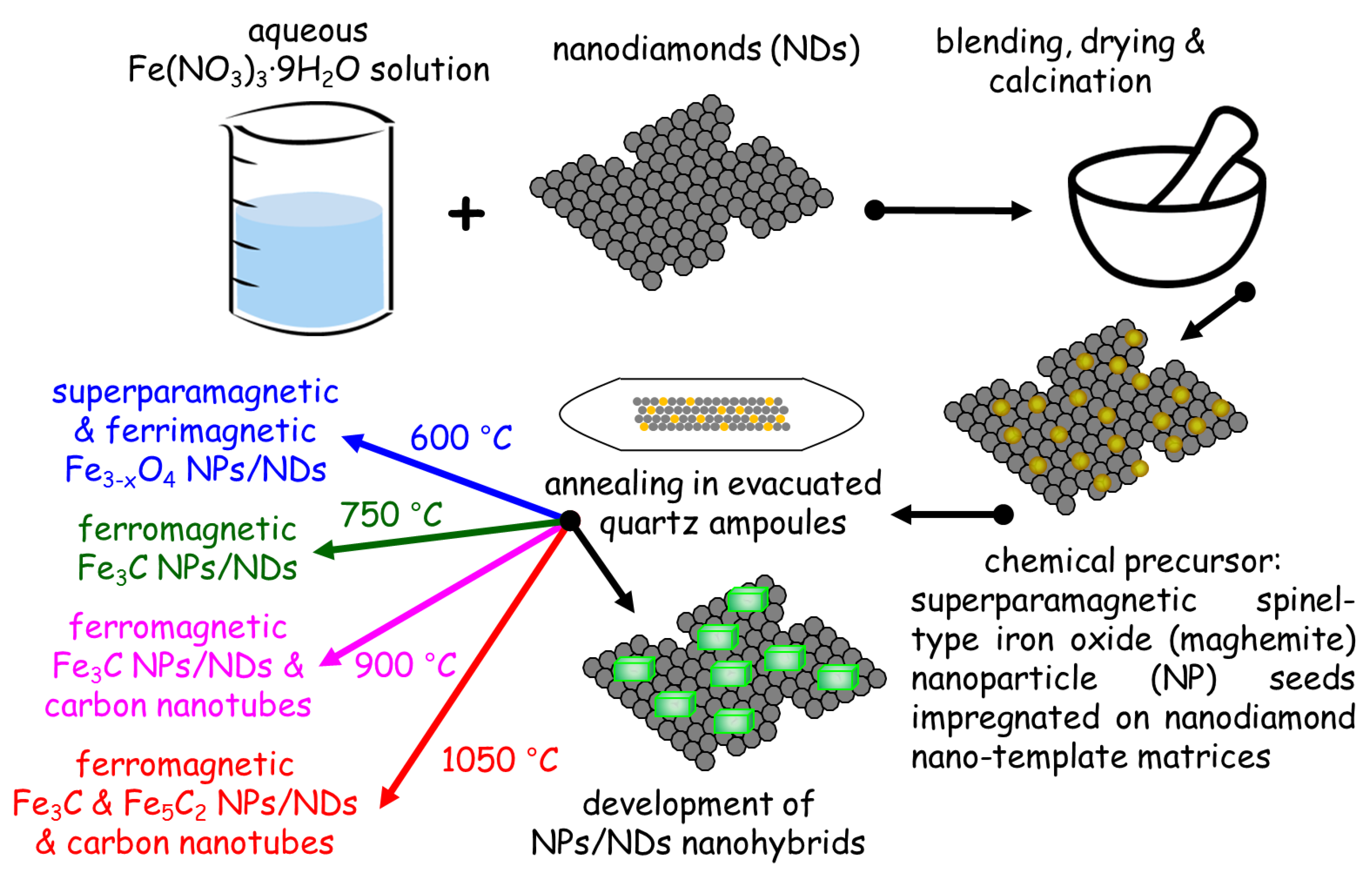
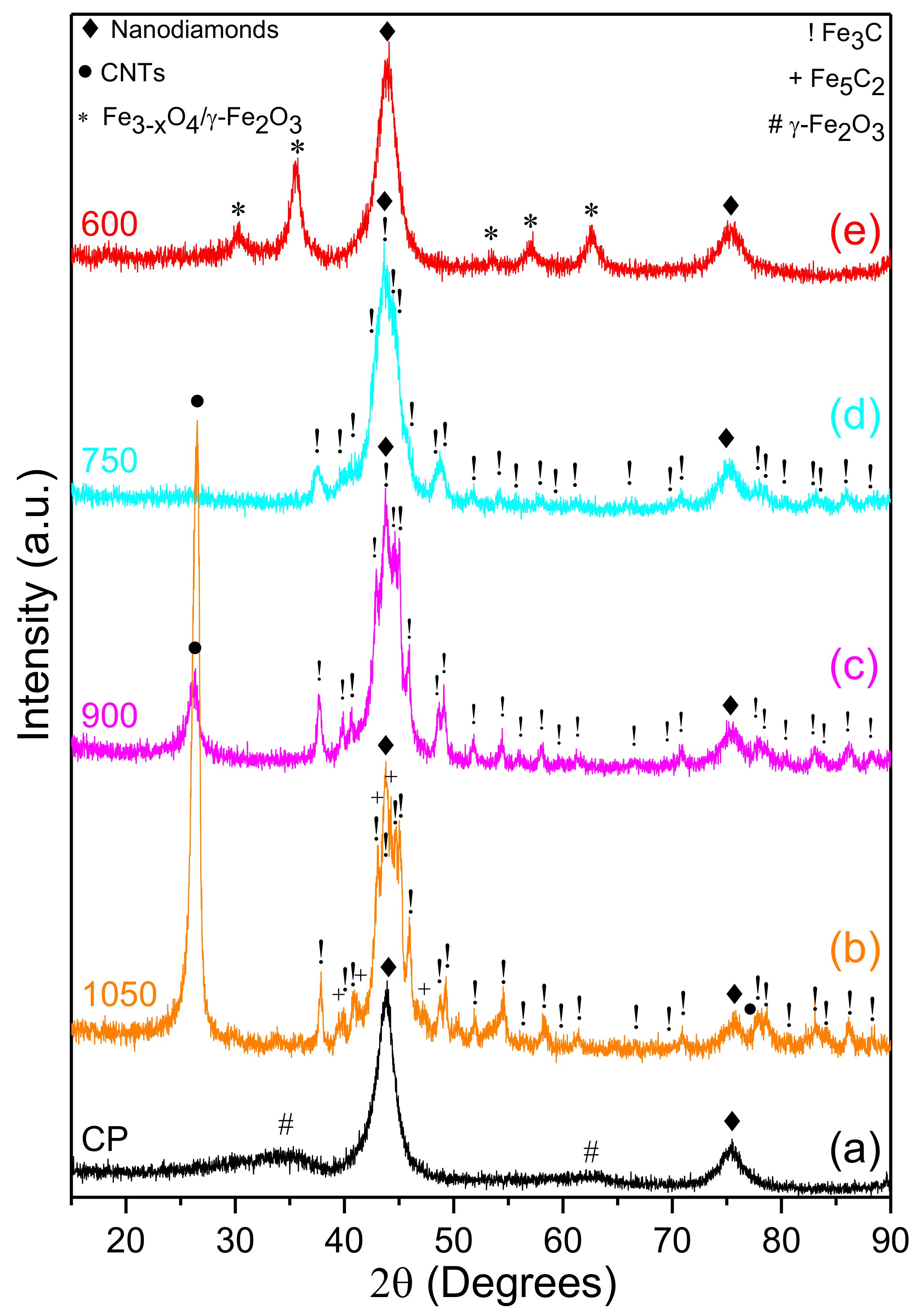
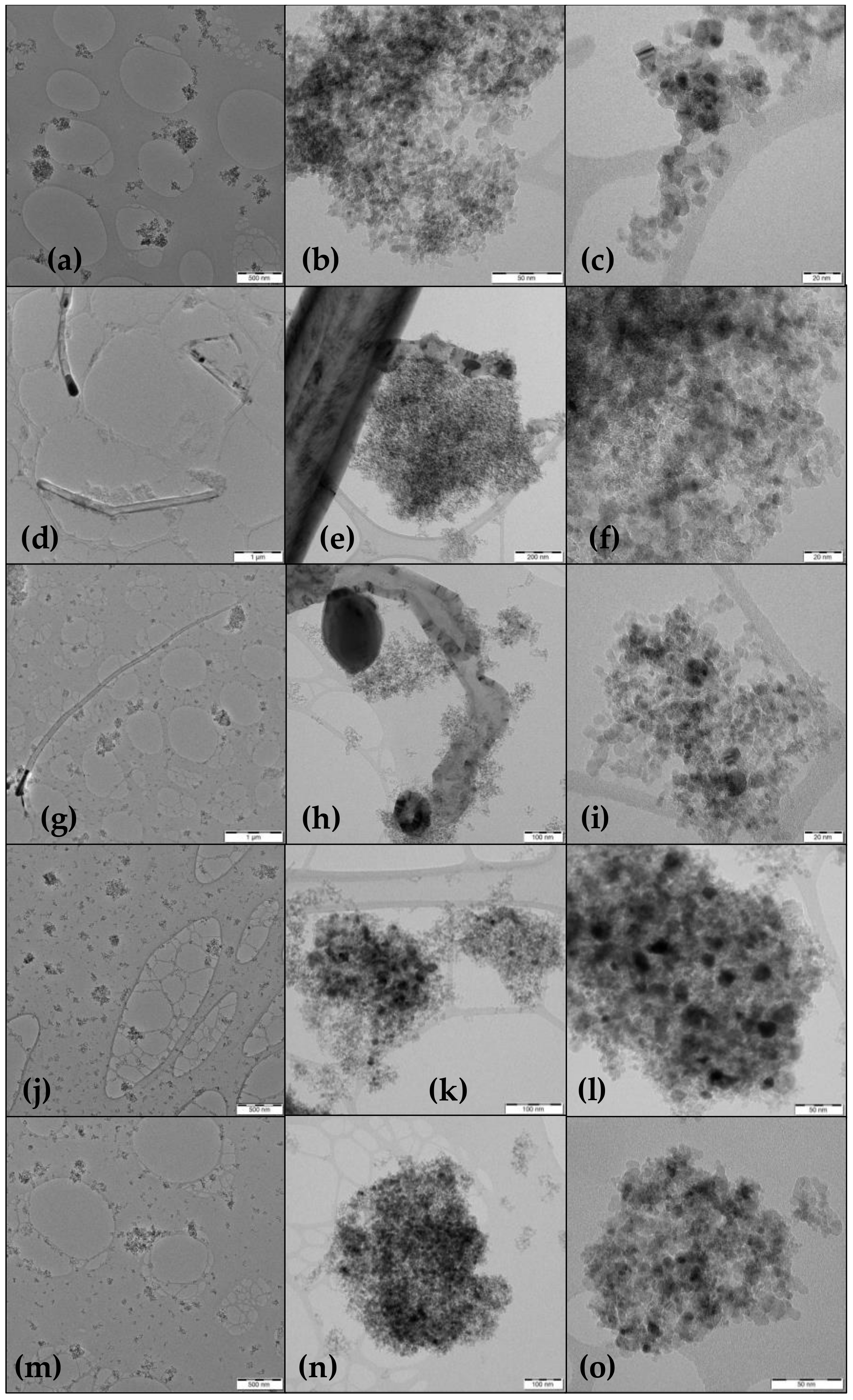
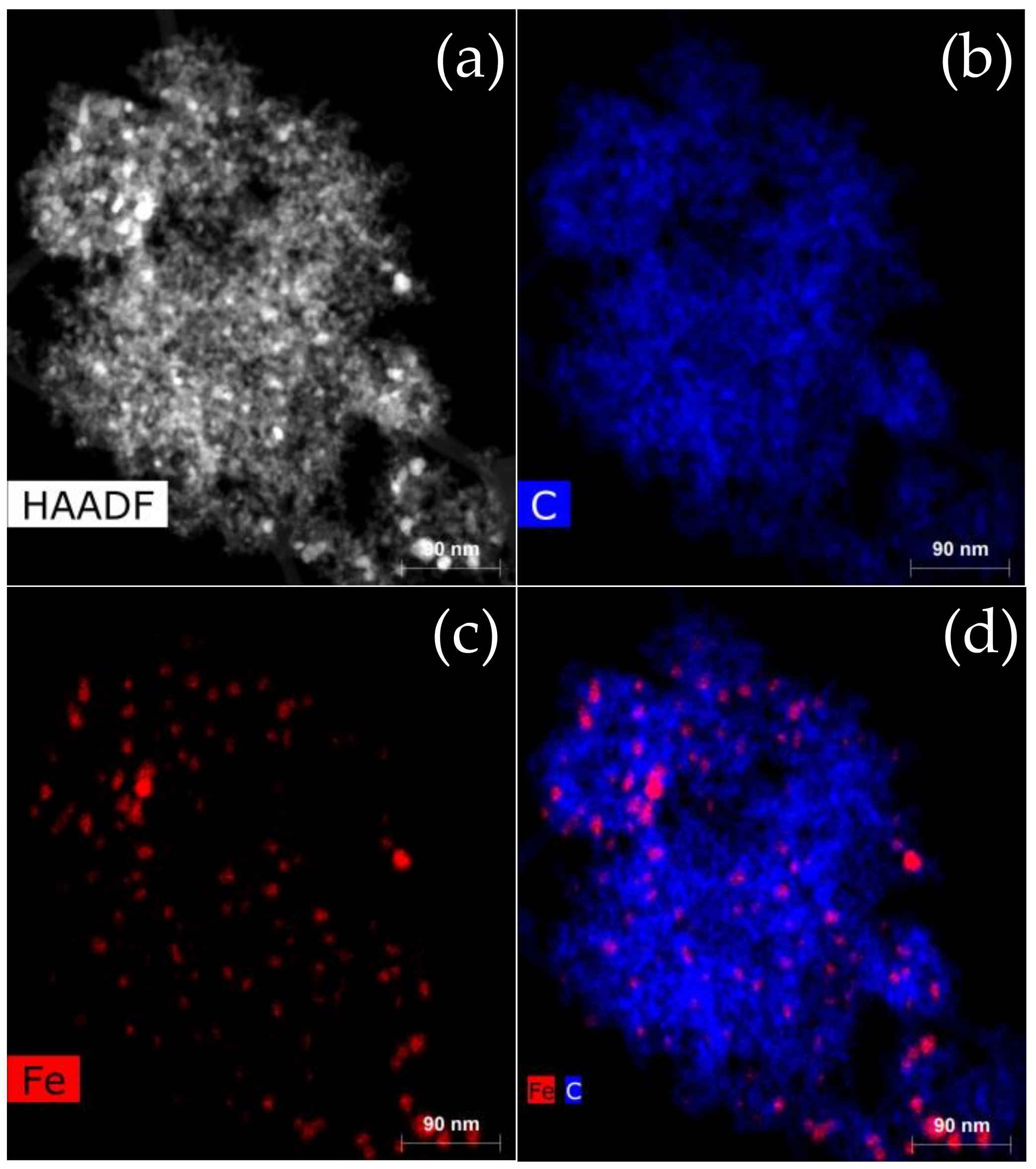
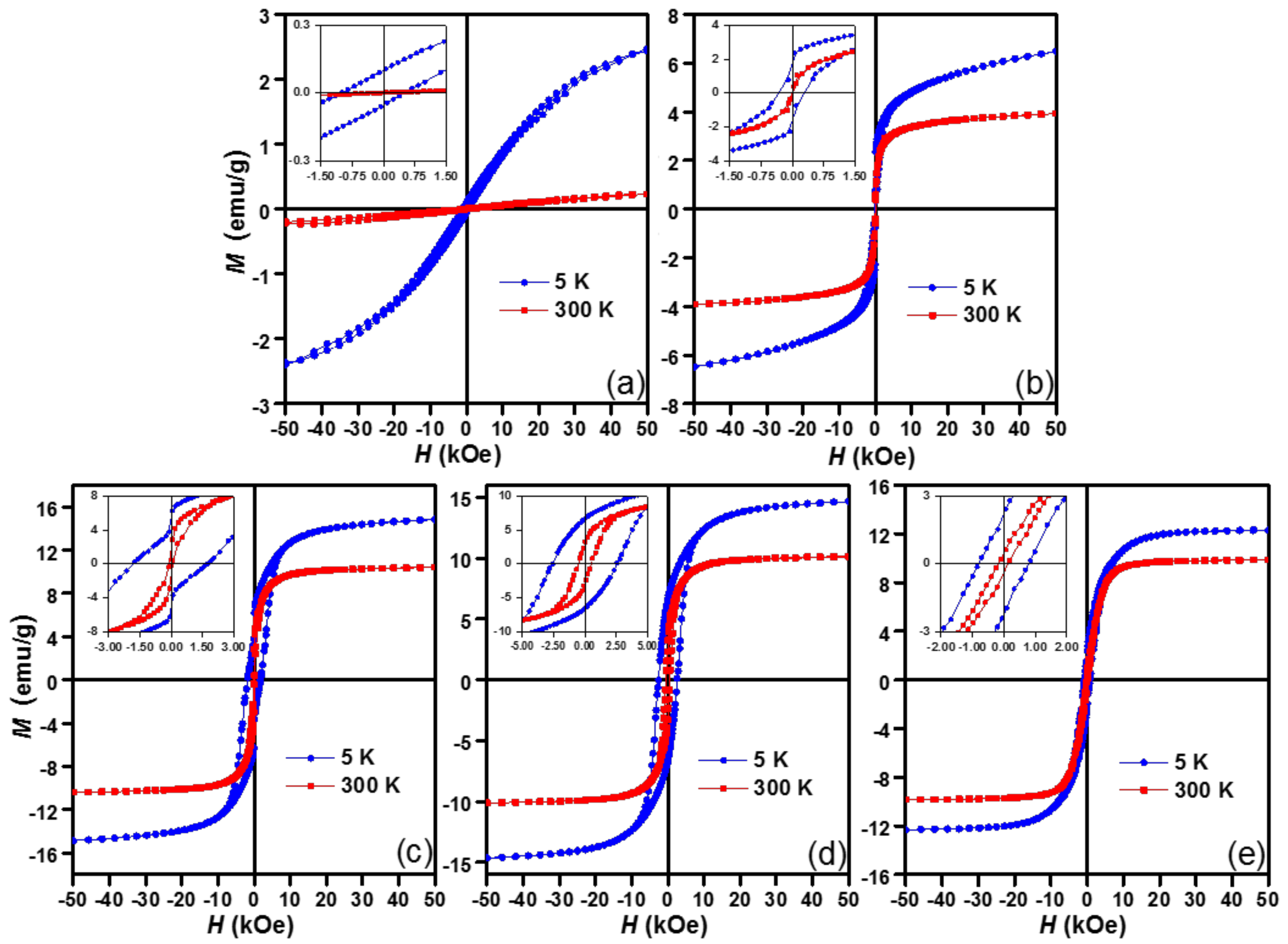
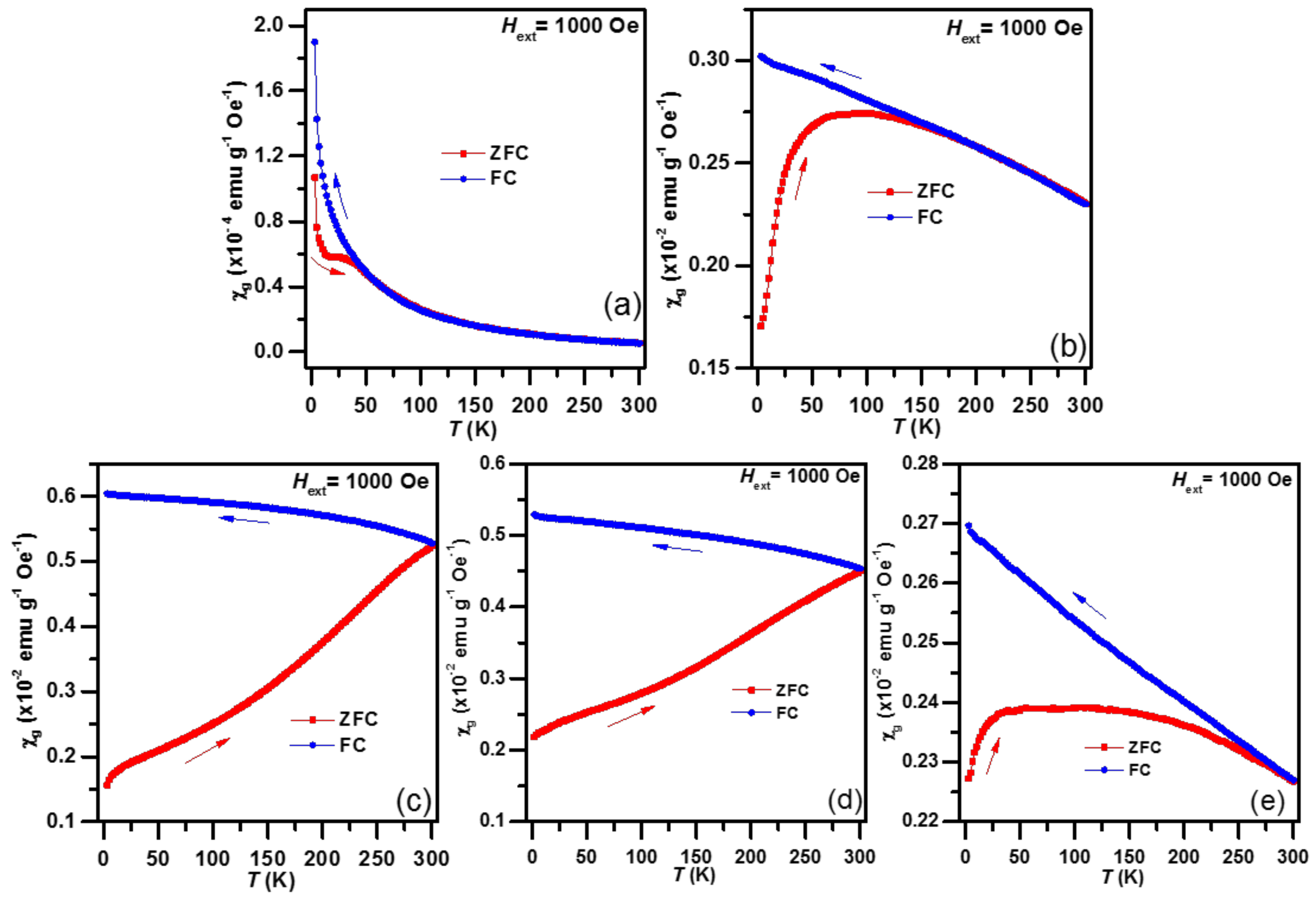
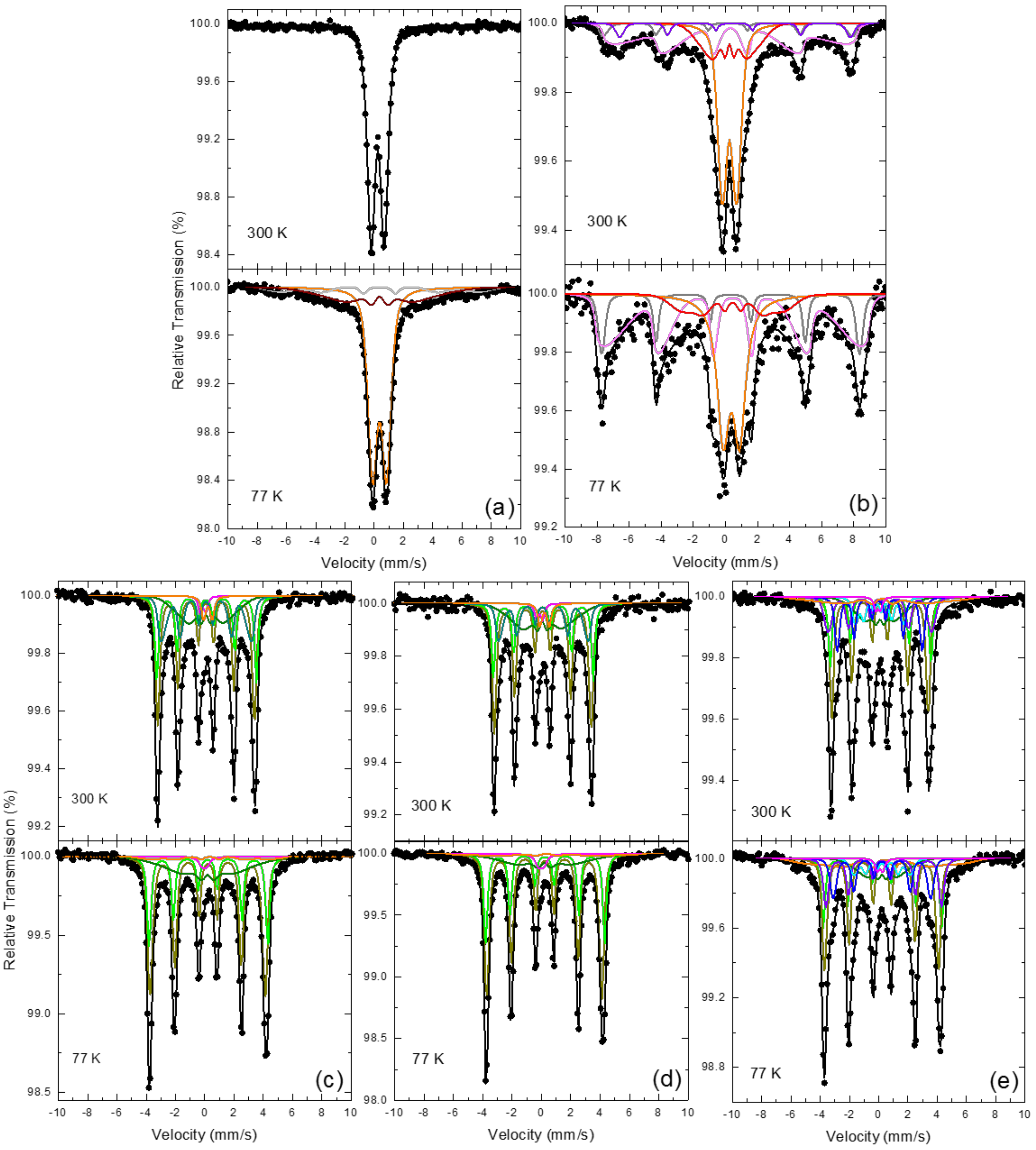
| Sample | NDs | Fe3C | Fe5C2 | Spinel-Type Iron Oxide | C-Graphitic |
|---|---|---|---|---|---|
| CP | 4 (1) | - | - | non-resolvable | - |
| NHD-1050 | 7 (1) | 20 (1) | 16 (1) | - | 11 (1) |
| NHD-900 | 5 (1) | 16 (1) | - | - | 8 (1) |
| NHD-750 | 5 (1) | 12 (1) | - | - | - |
| NHD-600 | 4 (1) | - | - | 9 (1) | - |
| Sample | T (K) | Mmax+ (emu/g) | Mmax− (emu/g) | MR+ (emu/g) | MR− (emu/g) | Hc+ (kOe) | Hc− (kOe) |
|---|---|---|---|---|---|---|---|
| CP | 300 | 0.23 | −0.22 | 0.00 | 0.00 | 0.00 | 0.00 |
| 5 | 2.46 | −2.40 | 0.10 | −0.06 | 0.54 | −0.99 | |
| NHD-600 | 300 | 3.91 | −3.91 | 0.00 | 0.00 | 0.00 | 0.00 |
| 5 | 6.47 | −6.48 | 1.88 | −1.51 | 0.28 | −0.32 | |
| NHD-750 | 300 | 10.41 | −10.39 | 2.15 | −1.63 | 0.09 | −0.12 |
| 5 | 14.82 | −14.86 | 5.43 | −5.20 | 1.78 | −1.85 | |
| NHD-900 | 300 | 10.11 | −10.12 | 3.33 | −2.90 | 0.53 | −0.46 |
| 5 | 14.65 | −14.64 | 6.68 | −6.50 | 2.55 | −2.53 | |
| NHD-1050 | 300 | 9.84 | −9.84 | 0.51 | −0.35 | 0.14 | −0.16 |
| 5 | 12.27 | −12.30 | 2.26 | −2.25 | 0.80 | −0.80 |
| Sample | Component Assignment | IS (mm/s) | Γ/2 (mm/s) | QS or 2ε (mm/s) | Bhf (kOe) | ΔBhf (kOe) | AA (%) | CL |
|---|---|---|---|---|---|---|---|---|
| CP | SPM γ-Fe2O3 | 0.35 | 0.24 | 0.90 | 0 | 0 | 100 | B |
| NHD-600 | Fe3-xO4 (Fe3+) | 0.25 | 0.15 | −0.02 | 495 | 11/0 * | 7 | G |
| Fe3-xO4 (Fe2.5+) | 0.68 | 0.15 | 0.05 | 447 | 5/0 * | 5 | V | |
| SPM γ-Fe2O3 | 0.36 | 0.18 | 0.89 | 0 | 0 | 36 | O | |
| MCOL γ-Fe2O3/Fe3-xO4 | 0.37 | 0.12 | 0.02 | 102 | 38 | 17 | R | |
| MRES Fe3-xO4 | 0.41 | 0.15 | 0.00 | 489 | 78/0 * | 35 | LM | |
| NHD-750 | Fe3C (1) | 0.19 | 0.14 | 0.01 | 209 | 3/0 * | 36 | DY |
| Fe3C (2) | 0.21 | 0.14 | 0.05 | 212 | 0 | 20 | GR | |
| MCOL Fe3C | 0.20 | 0.14 | 0.03 | 110 | 45 | 17 | OL | |
| MRES Fe3C | 0.20 | 0.14 | 0.03 | 202 | 12/0 * | 22 | DC | |
| SPM metallic Fe | −0.02 | 0.15 | 0.38 | 0 | 0 | 2 | M | |
| SPM Fe3+ (IO) | 0.32 | 0.16 | 0.58 | 0 | 0 | 3 | O | |
| NHD-900 | Fe3C (1) | 0.19 | 0.14 | 0.01 | 209 | 3/0 * | 39 | DY |
| Fe3C (2) | 0.21 | 0.14 | 0.05 | 212 | 0 | 21 | GR | |
| MCOL Fe3C | 0.20 | 0.14 | 0.07 | 119 | 53 | 19 | OL | |
| MRES Fe3C | 0.20 | 0.14 | 0.07 | 198 | 9/0 * | 16 | DC | |
| SPM metallic Fe | −0.02 | 0.15 | 0.42 | 0 | 0 | 2 | M | |
| SPM Fe3+ (IO) | 0.32 | 0.16 | 0.63 | 0 | 0 | 3 | O | |
| NHD-1050 | Fe3C (1) | 0.19 | 0.14 | 0.01 | 209 | 3/0 * | 27 | DY |
| Fe3C (2) | 0.21 | 0.14 | 0.05 | 214 | 0 | 15 | GR | |
| MCOL Fe3C | 0.20 | 0.14 | 0.02 | 91 | 47 | 13 | OL | |
| Fe5C2 (1) | 0.14 | 0.14 | 0.09 | 220 | 12 | 14 | V | |
| Fe5C2 (2) | 0.15 | 0.14 | 0.07 | 181 | 9 | 14 | BU | |
| Fe5C2 (3) | 0.10 | 0.14 | 0.12 | 103 | 5 | 9 | C | |
| SPM IC | 0.07 | 0.15 | 0.31 | 0 | 0 | 1 | M | |
| MCOL Fe3+ (IO) | 0.36 | 0.14 | 0.01 | 273 | 93 | 7 | O |
Publisher’s Note: MDPI stays neutral with regard to jurisdictional claims in published maps and institutional affiliations. |
© 2020 by the authors. Licensee MDPI, Basel, Switzerland. This article is an open access article distributed under the terms and conditions of the Creative Commons Attribution (CC BY) license (http://creativecommons.org/licenses/by/4.0/).
Share and Cite
Ziogas, P.; Bourlinos, A.B.; Tucek, J.; Malina, O.; Douvalis, A.P. Novel Magnetic Nanohybrids: From Iron Oxide to Iron Carbide Nanoparticles Grown on Nanodiamonds. Magnetochemistry 2020, 6, 73. https://doi.org/10.3390/magnetochemistry6040073
Ziogas P, Bourlinos AB, Tucek J, Malina O, Douvalis AP. Novel Magnetic Nanohybrids: From Iron Oxide to Iron Carbide Nanoparticles Grown on Nanodiamonds. Magnetochemistry. 2020; 6(4):73. https://doi.org/10.3390/magnetochemistry6040073
Chicago/Turabian StyleZiogas, Panagiotis, Athanasios B. Bourlinos, Jiri Tucek, Ondrej Malina, and Alexios P. Douvalis. 2020. "Novel Magnetic Nanohybrids: From Iron Oxide to Iron Carbide Nanoparticles Grown on Nanodiamonds" Magnetochemistry 6, no. 4: 73. https://doi.org/10.3390/magnetochemistry6040073
APA StyleZiogas, P., Bourlinos, A. B., Tucek, J., Malina, O., & Douvalis, A. P. (2020). Novel Magnetic Nanohybrids: From Iron Oxide to Iron Carbide Nanoparticles Grown on Nanodiamonds. Magnetochemistry, 6(4), 73. https://doi.org/10.3390/magnetochemistry6040073






